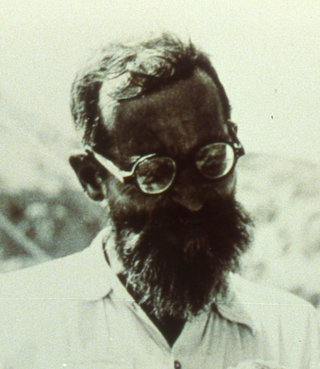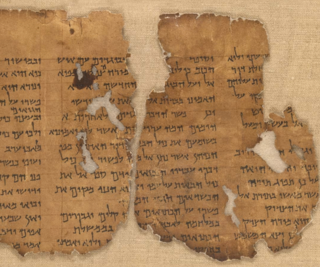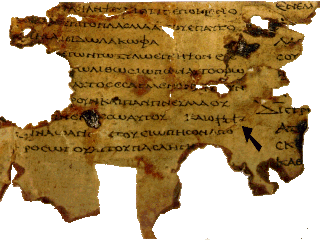Related Research Articles

The Dead Sea Scrolls are ancient Jewish religious manuscripts discovered between 1946 and 1956 at the Qumran Caves in what was then Mandatory Palestine, near Ein Feshkha in the West Bank, on the northern shore of the Dead Sea. Dating from the 3rd century BCE to the 1st century CE, the Dead Sea Scrolls are considered to be a keystone in the history of archaeology with great historical, religious, and linguistic significance because they include the oldest surviving manuscripts of entire books later included in the biblical canons, along with deuterocanonical and extra-biblical manuscripts which preserve evidence of the diversity of religious thought in late Second Temple Judaism. At the same time they cast new light on the emergence of Christianity and of Rabbinic Judaism. Almost all of the 15,000 scrolls and scroll fragments are held by Israel in the Shrine of the Book at the Israel Museum. Israel's custody of the scrolls is disputed by Jordan and the Palestinian Authority on territorial, legal and humanitarian grounds – they were mostly discovered during the period of Jordanian control of the West Bank and captured by Israel in the 1967 Six Day War – whilst Israel's claims are primarily based on historical and religious grounds given their significance in Jewish history and in the heritage of Judaism.

Qumran is an archaeological site in the West Bank managed by Israel's Qumran National Park. It is located on a dry marl plateau about 1.5 km (1 mi) from the northwestern shore of the Dead Sea, about 10 km (6 mi) south of the historic city of Jericho, and adjacent to the modern Israeli settlement and kibbutz of Kalya.

The Copper Scroll (3Q15) is one of the Dead Sea Scrolls found in Cave 3 near Khirbet Qumran, but differs significantly from the others. Whereas the other scrolls are written on parchment or papyrus, this scroll is written on metal: copper mixed with about 1 percent tin, although no metallic copper remained in the strips; the action of the centuries had been to convert the metal into brittle oxide. The so-called 'scrolls' of copper were, in reality, two separated sections of what was originally a single scroll about 2.4 metres (7.9 ft) in length. Unlike the others, it is not a literary work, but a list of 64 places where various items of gold and silver were buried or hidden. It differs from the other scrolls in its Hebrew, its orthography, palaeography and date.

The Damascus Document is an ancient Hebrew text known from both the Cairo Geniza and the Dead Sea Scrolls. It is considered one of the foundational documents of the ancient Jewish community of Qumran.

Roland Guérin de Vaux was a French Dominican priest who led the Catholic team that initially worked on the Dead Sea Scrolls. He was the director of the Ecole Biblique, a French Catholic Theological School in East Jerusalem, and he was charged with overseeing research on the scrolls. His team excavated the ancient site of Khirbet Qumran (1951–1956) as well as several caves near Qumran northwest of the Dead Sea. The excavations were led by Ibrahim El-Assouli, caretaker of the Palestine Archaeological Museum, or what came to be known as the Rockefeller Museum in Jerusalem.

Emanuel Tov, is a Dutch–Israeli biblical scholar and linguist, emeritus J. L. Magnes Professor of Bible Studies in the Department of Bible at the Hebrew University of Jerusalem. He has been intimately involved with the Dead Sea Scrolls for many decades, and from 1991, he was appointed Editor-in-Chief of the Dead Sea Scrolls Publication Project.

The Judaean Desert or Judean Desert is a desert in the West Bank and Israel that lies east of Jerusalem and descends to the Dead Sea. Under the name El-Bariyah, it has been nominated to the Tentative List of World Heritage Sites in the State of Palestine, particularly for its monastic ruins.

Robert Eisenman is an American biblical scholar, historian, archaeologist, and poet. He is currently professor of Middle East religions, archaeology, and Islamic law and director of the Institute for the Study of Judaeo-Christian Origins at California State University Long Beach.
The Community Rule, which is designated 1QS and was previously referred to as the Manual of Discipline, is one of the first scrolls to be discovered near khirbet Qumran, the scrolls found in the eleven caves between 1947 and 1954 are now referred to simply as the Dead Sea Scrolls. The Rule of the Community is a key sectarian document and is seen as definitive for classifying other compositions as sectarian or non-sectarian. Among the nearly 350 documents discovered, roughly 30% of the scrolls are classified as "sectarian".

The Habakkuk Commentary or Pesher Habakkuk, labelled 1QpHab, was among the original seven Dead Sea Scrolls discovered in 1947 and published in 1951. Due to its early discovery and rapid publication, as well as its relatively pristine preservation, 1QpHab is one of the most frequently researched and analyzed scrolls of the several hundred now known.

Frank Moore Cross Jr. (1921–2012) was the Hancock Professor of Hebrew and Other Oriental Languages Emeritus at Harvard University, notable for his work in the interpretation of the Dead Sea Scrolls, his 1973 magnum opusCanaanite Myth and Hebrew Epic, and his work in Northwest Semitic epigraphy. Many of his essays on the latter topic have since been collected in Leaves from an Epigrapher's Notebook.

Elisha Qimron is an academic who studies ancient Hebrew. He took his Doctor of Philosophy in 1976 at the Hebrew University of Jerusalem with the dissertation The Hebrew of the Dead Sea Scrolls.

4QMMT, also known as MMT, or the Halakhic Letter, is a reconstructed text from manuscripts that were part of the Dead Sea Scrolls discovered at Qumran in the Judean desert. The manuscripts that were used to reconstruct 4QMMT were found in Cave 4 at Qumran between the years 1953 and 1959. They were kept at the Palestinian Archaeological Museum, now known as the Rockefeller Museum in Jerusalem.
The Isaiah Scroll, designated 1QIsaa and also known as the Great Isaiah Scroll, is one of the seven Dead Sea Scrolls that were first discovered by Bedouin shepherds in 1946 from Qumran Cave 1. The scroll is written in Hebrew and contains the entire Book of Isaiah from beginning to end, apart from a few small damaged portions. It is the oldest complete copy of the Book of Isaiah, being approximately 1000 years older than the oldest Hebrew manuscripts known before the scrolls' discovery. 1QIsaa is also notable in being the only scroll from the Qumran Caves to be preserved almost in its entirety.

Qumran Caves are a series of caves, both natural and artificial, found around the archaeological site of Qumran in the Judaean Desert. It is in these caves that the Dead Sea Scrolls were discovered.

The W. F. Albright Institute of Archaeological Research (AIAR) is an archaeological research institution located in East Jerusalem. It is the oldest American research center for ancient Near Eastern studies in the Middle East. Founded in 1900 as the American School of Oriental Research, it was renamed in 1970 after its most distinguished director and the father of biblical archaeology, William F. Albright. Its mission is to develop and disseminate scholarly knowledge of the literature, history, and culture of the Near East, as well as the study of civilization from pre-history to the early Islamic period.

Hanan Eshel was an Israeli archaeologist and historian, well known in the field of Dead Sea Scrolls studies, although he did research in the Hasmonean and Bar Kokhba periods as well. With Magen Broshi he discovered a number of residential caves in the near vicinity of Qumran and co-published a number of historically significant documents from Qumran.

The Greek Minor Prophets Scroll from Nahal Hever is a Greek manuscript of a revision of the Septuagint dated to the 1st century CE. The manuscript is kept in the Rockefeller Museum in Jerusalem. It was first published by Dominique Barthélemy in 1963. The Rahlfs-Siglum is 943.
The Great Psalms Scroll, also referred to as 11Q5, is the most substantial and well preserved manuscript of Psalms of the thirty-seven discovered among the Dead Sea Scrolls in the Qumran caves. It is one of six Psalms manuscripts discovered in Cave 11.

Paleo-Hebrew Leviticus Scroll, known also as 11QpaleoLev, is an ancient text preserved in one of the Qumran group of caves, and which provides a rare glimpse of the script used formerly by the Israelites in writing Torah scrolls during pre-exilic history. The fragmentary remains of the Torah scroll is written in the Paleo-Hebrew script and was found stashed away in cave no. 11 at Qumran, showing a portion of Leviticus. The scroll is thought to have been penned by the scribe between the late 2nd century BCE to early 1st century BCE, while others place its writing in the 1st century CE.
References
- 1 2 Greenberg, Joel (2000-08-31). "Israeli Court Upholds Scholar's Rights to Dead Sea Scrolls Work". The New York Times. ISSN 0362-4331 . Retrieved 2018-05-15.
- 1 2 3 MacQueen, Hector L. (2010-10-28). "The Scrolls and the Legal Definition of Authorship". In Collins, John J; Lim, Timothy H (eds.). The Oxford Handbook of the Dead Sea Scrolls. doi:10.1093/oxfordhb/9780199207237.001.0001. ISBN 9780199207237.